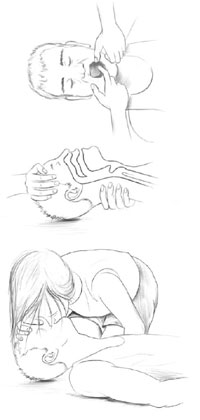Performing Mouth-to-Mouth Resuscitation
Performing Mouth-to-Mouth Resuscitation
If you've been certified and trained to do CPR, go to it at the first sign of breathing problems or an erratic heartbeat. But if you don't know CPR, do not attempt to try it during your first emergency. Instead, get help immediately. While you are waiting, try mouth-to-mouth resuscitation; it can help save a life.
The following steps teach you how to do mouth-to-mouth.

resuscitation.
- First, ascertain whether the unconscious person is breathing at all. Bend down and place your ear near his or her mouth and nose and listen for signs of respiration. Look at his or her chest and see if you can see signs of exhalation. Hopefully, all is not lost and the person is breathing, even if it is faint.
- Position the injured person on his back.
- Put on latex gloves for universal safety measures. Open his or her mouth and use your fingers to remove any obstructions in the throat or airway.
- To avoid transmission of HIV or other deadly viruses via saliva, place your disposable airway bag over your mouth and over the injured person's mouth. (Obviously, if this is an intimate family member, you will not have to practice this universal safety feature.)
- Put one hand under the injured person's neck, and place the other hand on his forehead. Tilt the head back as far as you can to keep the airway clear. The injured person's mouth should be open.
- Pinch the nostrils to close them.
- Take a deep breath.
- Cover the injured person's mouth completely with your own.
- Exhale hard into the injured person's mouth. Repeat four times.
- If you are working on an adult, stop for five seconds, and then repeat steps 6–9 giving only one breath.
If you are working on a child or infant, stop for three seconds, and then repeat steps 6–9 giving only one breath. - Repeat this process until the victim begins breathing, until you feel a pulse, or until help arrives. During the time you're not breathing into the person's mouth, continue to call for help.
- Remember the ABCs. Take a brief pause in-between your resuscitations to check the victim's Airways, Breathing, and Circulation.
Treating for Shock
When an individual goes into shock, the body's chemistry goes out of whack. Balance must be restored—quickly. There are different degrees of shock, but expect some obvious symptoms whenever an accident occurs. Signs of shock include:
| Weakness | Nausea |
| Clammy, pale, cold skin | Chills |
| Erratic breathing | Faintness or unconsciousness |
| Weak and/or fast pulse |
If a victim goes into shock, don't panic. Perform the ABCs of first aid: clear Airways, check Breathing, and maintain Circulation. Cover the injured person with a blanket to keep her warm. Then lay her down, keep her quiet, and elevate the feet to maximize blood flow to the brain.
Above all, get help as quickly as you can.